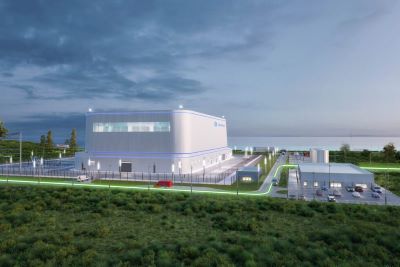Building new nuclear reactors in Canada is not the solution to the climate crisis
Building new nuclear power reactors is folly and won’t help mitigate the climate crisis, say scientists at the University of British Columbia (UBC) and Stanford University.
 Despite about 20 countries including Canada declaring plans to triple nuclear energy by 2050 and the backing of billionaires like Bill Gates, Canada should not support expanding nuclear power, said M.V. Ramana (photo at right) the Simons Chair in Global Disarmament and Human Security in UBC’s School of Public Policy and Global Affairs.
Despite about 20 countries including Canada declaring plans to triple nuclear energy by 2050 and the backing of billionaires like Bill Gates, Canada should not support expanding nuclear power, said M.V. Ramana (photo at right) the Simons Chair in Global Disarmament and Human Security in UBC’s School of Public Policy and Global Affairs.
Ramana is the author of the book, Nuclear is Not the Solution: The Folly of Atomic Power in the Age of Climate Change.
In a Q&A published by UBC last September, Ramana shared key insights from the book and why nuclear power does not help mitigate climate change.
What motivated you to write this book?
Just 20 or 30 years ago, talking about nuclear energy as an environmentally friendly source of electricity would probably get you laughed out of the room.
But in the last decade, advocates of nuclear energy – from energy companies to governments and tech billionaires – have advertised the technology as a clean source of electricity that is vital to solving climate change.
Their arguments make no sense given what we know about the history and the technical characteristics of nuclear energy, so one motivation for this book is to lay out those arguments yet again, because they seem to have been forgotten.
How do you respond to claims that nuclear energy is necessary for meeting our carbon reduction goals?
Many technologies have low-carbon footprints but we need to consider two other important factors: cost and deployment time.
Nuclear energy is one of the most expensive ways to generate electricity. Investing in cheaper low-carbon sources of energy will provide more emission reductions per dollar. Second, it takes about a decade to build a nuclear plant. If you add the time needed for environmental clearances, community consent and raising the huge amounts of funding necessary, you’re looking at 15 to 20 years before a nuclear project can even start producing electricity. This timeline is incompatible with the urgent demands of climate science.
Thus, nuclear power fails on two key metrics for evaluating any technology claiming to deal with climate change.
What risks associated with nuclear energy are most overlooked by its proponents?
First, nuclear reactors by their very nature are susceptible to catastrophic releases of energy and radioactivity – we’ve seen that happen with Fukushima and Chernobyl. It’s impossible to guarantee severe accidents won’t happen again.
Second, all activities linked to the nuclear fuel chain, from mining uranium to dealing with the radioactive wastes produced, have significant public and environmental impacts. Some radioactive materials remain hazardous for hundreds of thousands of years. There is no demonstrated solution to managing these wastes.
Third, the technology to generate nuclear power is closely tied to the one to make nuclear weapons. Expanding nuclear energy will increase the potential for nuclear weapons proliferation.
Proponents downplay all these problems. But as I explain in my book, they will afflict new nuclear reactors too.
What renewable energy sources are most promising, and how can we accelerate their adoption?
Solar energy has become the cheapest power source in the past decade, with solar and wind now leading new-electricity generation.
We have learned how to manage grids with high proportions of renewable sources. To balance this variability, we must invest in a mix of renewable energy technologies across various regions, and in battery and other storage technologies to store excess energy. In addition, we need to shape electricity demand to more closely match supply.
These renewables are not a panacea, but they seem to be the best option. Addressing climate change isn’t just about technology; it’s also about making appropriate social and political changes. For reasons discussed in my book, nuclear power is incompatible with the kind of social and political transformations needed to address climate change.
No good solution for nuclear waste
In a video done by the Wyoming Liberty Group and posted on YouTube, Ramana said the spent nuclear fuel waste from reactors will stay radioactive and hazardous for hundreds of thousands of years. “I don’t think we should be rushing into solutions.”
Nuclear energy is currently producing around nine percent of the world’s electricity, a decline from about 17 percent in the mid-1990s, he said. In the U.S., about 18 percent of the country’s electricity is nuclear power.
“Building one of these nuclear reactors is a very expensive proposition,” Ramana said.
The last two reactors built in the U.S., in Georgia, ended up costing about $36 billion, up from the $14-billion initial cost.
Under the 2005 Energy Policy Act implemented under the George W. Bush administration, which included various incentives for nuclear energy companies, there were plans for building about 30 new nuclear reactors in the U.S., Ramana said.
Only four reactors went into construction and two of these in South Carolina were cancelled after about $9 billion was spent. “All the people of South Carolina got for it was a big hole in the ground.”
Every new nuclear plant is going to be very expensive and the only way nuclear developers will be able to get started on these projects “is by pretending it’s going to cost less than it’s finally going to cost,” Ramana said.
All nuclear reactors are vulnerable to accidents under certain circumstances, which results in radioactive materials being released into the atmosphere, he noted.
There has been almost no progress during the last 60+ years in managing radioactive nuclear waste, he said. Essentially, every nuclear power plant, including those in Canada, currently stores all its waste onsite.
A proposed deep geological repository to store spent nuclear fuel and highly radioactive nuclear waste, beneath Yucca Mountain in Nevada, hasn’t proceeded due to strong opposition and significant political hurdles. “It is not likely to happen anytime soon,” Ramana said.
A nuclear waste isolation pilot plant repository in New Mexico, meant to store waste resulting from the U.S. nuclear weapons program, had an accident in 2014 – about 15 years after the facility started operating – that involved an explosion of a drum of nuclear waste and exposed more than 20 workers to a release of radioactive plutonium.
The accident cost the U.S. more than $1 billion and the cleanup cost about $640 million. The facility was shut down for three years and resumed limited waste-disposal operations in 2017.
“There is no good solution for nuclear waste,” Ramana said. “The best solution that the industry has come up with is to say we’re going to dig a deep hole somewhere and bury it. This is not going to be fair to the people who live near there.”
“We need to stop producing more radioactive nuclear waste, because we don’t know how to deal with it in any way that’s demonstrably safe.”
Ramana pointed out that in contrast to nuclear power, the deployment of solar and wind energy worldwide has grown very rapidly.
From the mid-1990s to now, when the amount of nuclear power worldwide declined by about half, solar and wind energy have gone from about half-a-percent to over 15 percent, he said. “They are now the cheapest sources of electricity.”
The cost of solar-generated electricity declined by about 90 percent from 2010 to 2020, Ramana noted. “I think that’s the direction to be going in, the direction to explore.”
Seven reasons why nuclear energy is not the answer to climate change
 One nuclear power plant takes on average about 14 ½ years to build, from the planning phase all the way to operation, said Mark Z. Jacobson (photo at right), professor of civil and environmental engineering and director of the atmosphere/energy program at Stanford University,
One nuclear power plant takes on average about 14 ½ years to build, from the planning phase all the way to operation, said Mark Z. Jacobson (photo at right), professor of civil and environmental engineering and director of the atmosphere/energy program at Stanford University,
According to the World Health Organization, about 7.1 million people die from air pollution each year, with more than 90 percent of these deaths from energy-related combustion, he said.
“So switching out our energy system to nuclear would result in about 93 million people dying, as we wait for all the new nuclear plants to be built in the all-nuclear scenario.”
Utility-scale wind and solar farms, on the other hand, take on average only two to five years to build, from the planning phase to operation, Jacobson said.
Rooftop solar PV projects are down to only a six-month timeline. “So transitioning to 100-percent renewables as soon as possible would result in tens of millions fewer deaths,” he said.
Jacobson, in an article published last October by One Earth, offered seven reasons why nuclear energy is not the answer to solving climate change.
- Long time lag between planning and operation.
The planning-to-operation times of all nuclear plants ever built have been 10 to 19 years or more. The time lag between planning and operation of a nuclear reactor includes the times to identify a site, obtain a site permit, purchase or lease the land, obtain a construction permit, obtain financing and insurance for construction, install transmission, negotiate a power purchase agreement, obtain permits, build the plant, connect it to transmission and obtain a final operating license.
- The levelized cost of energy (LCOE) for a new nuclear plant, based on estimates in a 2024 report by global financial services firm Lazard, ranges from $122 to $284 per megawatt-hour (MWh). This compares with $45 to $133 per MWh for onshore wind and $60 to $210 for utility-scale solar photovoltaic.
This nuclear LCOE is an underestimate for several reasons, Jacobson said. First, Lazard assumes a construction time for nuclear of 5.75 years. However, the Vogtle 3 and 4 reactors in Georgia will take at least 8.5 to nine years to finish construction. This additional delay alone results in an estimated LCOE for nuclear of about $172 per MWh, or a cost 2.3 to 7.4 times that of an onshore wind farm or utility PV farm.
The LCOE also does not include the cost of the major nuclear meltdowns in history. For example, the estimated cost to clean up the damage from three Fukushima Dai-ichi nuclear reactor core meltdowns was $460 billion to $640 billion. This is $1.2 billion, or 10 to 18.5 percent of the capital cost, of every nuclear reactor worldwide.
In addition, the LCOE does not include the cost of storing nuclear waste for hundreds of thousands of years. In the U.S. alone, about $500 million is spent yearly to safeguard nuclear waste generated by about 100 civilian nuclear energy plants.
“This amount will only increase as waste continues to accumulate. After the plants retire, the spending must continue for hundreds of thousands of years with no revenue stream from electricity sales to pay for the storage,” Jacobson said.
- Weapons proliferation risk.
The growth of nuclear energy has historically increased the ability of nations to obtain or harvest plutonium or enrich uranium to manufacture nuclear weapons.
The Intergovernmental Panel on Climate Change concluded in the executive summary of its 2014 report on energy, with “robust evidence and high agreement,” that nuclear weapons proliferation concern is a barrier and risk to the increasing development of nuclear energy.
- Meltdown risk.
To date, 1.5 percent of all nuclear power plants ever built have melted down to some degree.
Meltdowns have been either catastrophic (Chernobyl, Ukraine in 1986; three reactors at Fukushima Dai-ichi, Japan in 2011) or damaging (Three-Mile Island in 1979; Saint-Laurent France in 1980).
The nuclear industry has proposed new reactor designs that it suggests are safer. “However, these designs are generally untested, and there is no guarantee that the reactors will be designed, built and operated correctly or that a natural disaster or act of terrorism, such as an airplane flown into a reactor, will not cause the reactor to fail, resulting in a major disaster,” Jacobson said.
- Mining lung cancer risk.
Uranium mining causes lung cancer in large numbers of miners because uranium mines contain natural radon gas, some of whose decay products are carcinogenic. A study of 4,000 uranium miners between 1950 and 2000 found that 405 (10 percent) died of lung cancer, a rate six times that expected based on smoking rates alone. Sixty-one others died of mining-related lung diseases.
- Carbon-equivalent emissions and air pollution.
“There is no such thing as a zero- or close-to-zero emission nuclear power plant,” Jacobson said. Even existing plants produce emissions due to the continuous mining and refining of uranium needed for the plant.
Emissions from new nuclear facilities are 78 to 178 grams of carbon dioxide per kilowatt-hour (g-CO2/kWh), “not close to zero.”
Of this, 64 to 102 g-CO2/kWh over 100 years are emissions from the background grid while consumers wait 10 to 19 years for nuclear to come online or be refurbished, compared with two to five years for wind or solar.
In addition, all nuclear plants emit 4.4 g-CO2equivalent/kWh from the water vapor and heat they release.
This contrasts with solar panels and wind turbines, which reduce heat or water vapor fluxes to the air by about 2.2 g-CO2equivalent/kWh for a net difference from this factor alone of 6.6 g CO2equivalent/kWh greater for nuclear.
- Waste risk.
Consumed fuel rods from nuclear plants are radioactive waste. Most fuel rods are stored at the same site as the reactor that consumed them. This has given rise to hundreds of radioactive waste sites in many countries that must be maintained and funded for at least 200,000 years, far beyond the lifetimes of any nuclear power plant.
The more nuclear waste that accumulates, the greater the risk of radioactive leaks, which can damage water supply, crops, animals and humans.
Moreover, a dozen independent scientific groups have further found that it is possible to match intermittent power demand with clean, renewable energy supply and storage, without nuclear, at low cost, Jacobson noted.
A breakthrough climate model shows that the world has a window to stay below the dangerous threshold of 1.5º Celsius, achieving net-zero emissions before 2040, he said.
The two-year collaboration with 17 leading scientists, entitled Achieving the Paris Climate Agreement Goals, “shows that we can prevent the worst impacts of climate change while unlocking trillions in economic benefits through rapid decarbonization of our energy systems, a transition to 100-percent renewable energy and large-scale land restoration.”
R$
| Organizations: | |
| People: | |
| Topics: |
Events For Leaders in
Science, Tech, Innovation, and Policy
Discuss and learn from those in the know at our virtual and in-person events.
See Upcoming Events



.jpg)
.jpg)
